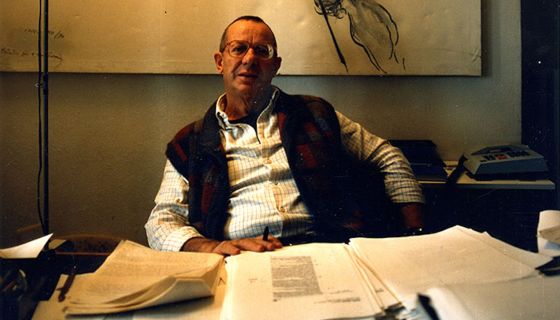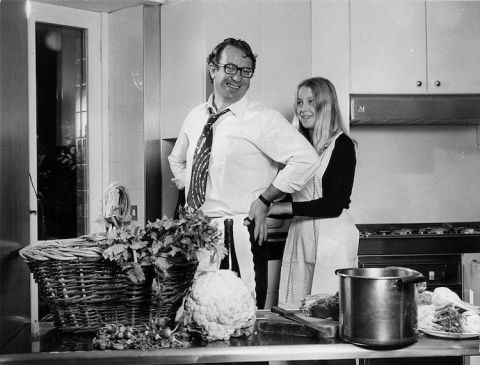Most of us know someone who is fastidious about the quality of what they eat and drink. But I can think of only one such person who was so influential that he virtually created modern wine and promulgated the principles of gastronomy throughout his native land: Luigi Veronelli, an Italian self-proclaimed anarchist who died in 2004.
Today we take the likes of Sassicaia, the intricate network of crus in Barolo and Barbaresco, and the freshness of Friulian whites for granted. Veronelli claimed credit for them and much else – with justification in many cases. His vast cellar is unique, still extant, and the current target of Italophile, Edinburgh-based Zubair Mohamed of Raeburn Fine Wines, who would like to share its impeccably stored treasures more widely. He organised a lunch in London last December designed to show the Veronelli family how much interest there would be in their wines in the UK.
Veronelli’s word, whether in newspaper columns, magazines or on television, was so powerful that in 1977 he managed to get Coca-Cola banned from Italy, temporarily but entirely, because, he argued, its ingredients were industrial rather than nourishing. He needed police protection for some months. (Early on he translated the writings of Marquis de Sade so accurately that his book was banned, a cause of some financial hardship for Veronelli.)
He was born into a prosperous Milanese family in 1926, studied philosophy and always wanted to write. Graduating in an Italy recovering from the war, he applied to Il Giorno, the Milan-based newspaper, to write about philosophy. That post was apparently – today rather surprisingly – already filled. It was therefore suggested he might like to write about his other interests. Thus was born Italy’s most powerful gastronomic critic.
For him food and drink were philosophical and, above all, cultural. Wine and food (he was an important restaurant critic) were pretexts for writing about society. He travelled the length and breadth of Italy, identifying with and encouraging small-scale producers and railing against the increasing prevalence of wine production on an industrial scale.
In the early 1950s he visited all the major French wine regions to understand why French wine was then regarded as incontrovertibly the best. Returning to Italy, he argued for a proper set of rules in the image of France’s Appellation Contrôlée system which laid down strict production criteria and clearly identified and glorified the best vineyard sites.
In 1963 Italy’s Denominazione di Origine Controllata was introduced, in such a watered-down, lax form that Veronelli ignored it in his increasingly influential writing in favour of the high-quality vini da tavola that emerged in the 1970s: wines such as Sassicaia, Tignanello and Le Pergole Torte that were defiantly produced outside the DOC system as table wines.
He tried typing but abandoned it – too mechanical? – so all his pronouncements began life in longhand. In his 1985 profile of Veronelli in Life Beyond Lambrusco, the late Italian specialist Nicolas Belfrage MW pointed out, ‘he brought with him into wine journalism the aesthete’s exacting standards and convoluted style’, adding with tongue in cheek, ‘perhaps one of the reasons he is so respected it that no one can quite understand what he is saying’.
Veronelli’s next seminal voyage was to California in 1982 where he was impressed by the intelligent use of small French oak barrels, as advocated by the famous oenologist André Tchelistcheff. As a result, Italian wine producers turned en masse from the large old Slavonian casks that had been de rigueur and embarked on a love affair with barriques. France’s coopers owe Veronelli a great deal. And then, ever curious and in his search of authenticity, in 1989 he visited Georgia, the cradle of viticulture, for Veronelli the cradle of humanity.
Known to his friends as Gino, he made many enemies, producers too slick to be of interest or smaller ones he unaccountably ignored. But they were outnumbered by his acolytes, an army of ambitious wine producers who sought his guidance – and sometimes even his psychological counsel according to his youngest daughter, Lucia (pictured above with him many years ago) whose husband, Arturo Rota, spent years sorting out the Veronelli archive and now holds the key to his remarkable cellar.
Veronelli had moved from Milan to a busy family home in the narrow medieval streets of upper Bergamo in 1970 and, with his increasing prominence, needed a capacious cellar for all the bottles he was sent for assessment. (He never scored wines himself but published many a guide to them.) He excavated, with explosives, to a depth of 20 feet (6 m) so that the rock walls, with just two small, north-facing vents, maintain the temperature at 13 or 14 °C (55–57 °F) and the relative humidity is kept suitably high.
He designed special concrete bins, 1,700 of them, to hold the multiple bottles of each wine he intended to study over time. (Wine accompanied all meals, to be taken ‘with consciousness’ according to Lucia, and he never drank wine without bread.)
There are still 35,000 bottles in the cellar, and no lift. The family discussed the possibility of selling the collection with Sotheby’s in New York in 2013 but the auction house was overwhelmed by the sheer size of it.
Mohamed is made of sterner stuff. By early 2020 he had persuaded the family to let him have some of the collection but disaster struck. The whole trailer exploded en route to the UK and burnt to a crisp.
Since then he has managed successfully to ship some of Veronelli’s wines to selected London clubs and restaurants and would eventually like to see some in UK retail. (Some bottles have already been sold by New York merchants Astor and Chambers Street Wines.)
The cellar really is an archive of the progress of Italian wine, stuffed with bottles unavailable elsewhere. The oldest bottle, a 1785, was stolen but there is Chianti Classico aplenty from the 1970s when the softening technique of converting harsh malic acid (then considerable in these Tuscan reds) into softer lactic acid was relatively unknown. One of the most exciting wines served at the lunch was an initial, experimental 1975 Riserva from the Capannelle estate that was never released but was sent to Veronelli (and the famous Florence restaurant Enoteca Pinchiorri) for their comments.
Another was a Capitel Monte Fontana 1977 Recioto della Valpolicella Classico from Tedeschi, a very early promoter of the single-vineyard wines that are now ubiquitous. There was also a jeroboam of a 1974 Barbaresco Riserva from Alfredo and Giovanni Roagna, their first Riserva and 100% from the famous Pajè cru, although in those days the names of Piemontese crus were known only to locals.
There was Grattamacco’s revealing white wine from Bolgheri made back in the famous 1985 vintage, from 40-year-old Trebbiano and Malvasia vines. Unoaked and just 11% alcohol, it’s very different from the red bordeaux blends and Vermentinos with which we associate this Tuscan coastal wine region today.
Surprisingly, red wine constitutes less than half the bottles in the Veronelli cellar, with Friuli the second-biggest category, and 12% rosato according to the family. Veronelli was a major promoter of the fresh, temperature-controlled whites that emerged from Friuli from the 1970s. Their pioneer, Mario Schiopetto, was Veronelli’s most garlanded producer, and Veronelli followed many of his experiments, such as wines without the preservative sulphur dioxide as long ago as the 1970s.
According to Rota and the cellarmaster Luca Mazzoleni, the whites in the Veronelli cellar have if anything aged better than the reds, but in general the wines tend to taste 10 years younger than expected. That was certainly borne out by most of the 11 wines served at Mohamed’s lunch.
So far bottles have left the cellar only for special presentations but Mohamed is doing his best to extract more, even if they all have to be painstakingly carried upstairs.
Veronelli-inspired wines
These are particularly delicious, current examples of wines that Veronelli would argue he encouraged into existence.
Ronchi di Cialla, Ribolla Gialla 2022 Colli Orientali del Friuli 12.5%
From a Friuli producer that was close to Veronelli. Great ‘green leaf’ expression of the signature local grape variety.
£20.75 AG Wines, £21.25 Sociovino
Valentini 2017 Trebbiano d’Abruzzo 12.5%
Cult southern Italian white that’s sumptuously mineral. The debut vintage of its red stablemate, Valentini 1968 Montepulciano d’Abruzzo, was sent to Veronelli.
£140 Woodwinters, £175 Salusbury Winestore
Castello di Volpaia, Coltassala Gran Selezione 2016 Chianti Classico 14%
Intense, organically farmed Sangiovese with producer and art collector Giovanna Stanti’s speciality of a little spicy Mammolo. She had a long correspondence with Veronelli who often praised her ‘magnetic allure’.
£46.23 Lay & Wheeler
San Leonardo 2018 Vigneti delle Dolomiti 13%
Subalpine bordeaux blend aged in barriques in the image of the Supertuscans such as Sassicaia and Tignanello. The Veronelli cellar contains a 1961 ‘Trentino Cabernet di San Leonardo’ from this estate.
£73 Honest Grapes, £75 VINVM, £78 Four Walls Wine Company and others
For scores, tasting notes and suggested drinking dates see our tasting notes database. For international stockists see Wine-Searcher.com.
















